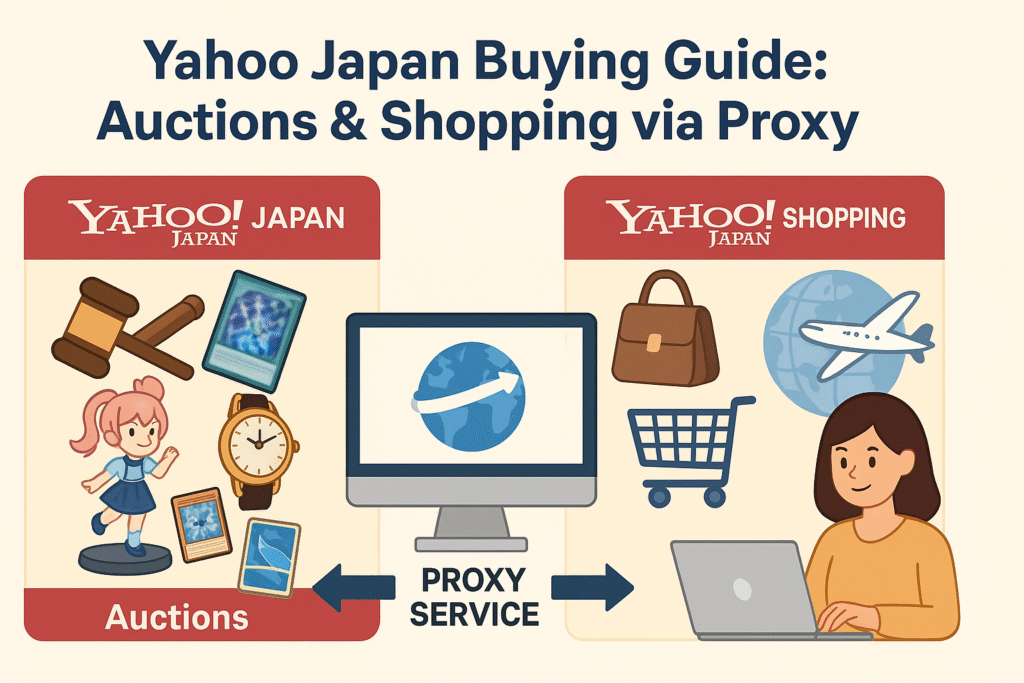Why Yahoo Japan Attracts Global Buyers
Earlier this year, a collector in California came across a vintage Seiko watch listed on Yahoo! Auctions Japan for nearly half the going price in the U.S. It looked like the deal of a lifetime—until reality set in. The seller accepted only Japanese payment methods, required a local account, and shipped exclusively within Japan. The watch remained out of reach, a familiar story for many international buyers.
That’s the paradox of Yahoo Japan. On one side, Yahoo! Auctions is the country’s largest online auction site, where second-hand treasures and rare collectibles appear daily. On the other, Yahoo! Shopping functions like a digital mall filled with countless retailers offering both new and used goods. Together they form one of Japan’s richest marketplaces, yet most overseas shoppers are blocked by practical hurdles.
This guide unpacks the differences between Auctions and Shopping, highlights the common barriers, and explains how proxy services make Yahoo Japan accessible to a global audience.
Auctions vs Shopping: What’s the Difference?
Understanding how Yahoo Japan is divided helps buyers set realistic expectations.
- Yahoo! Auctions: A C2C-heavy platform where individuals and small shops list items ranging from trading cards to luxury watches. Prices are determined by bidding, returns are not always guaranteed, and competition can be intense.
- Yahoo! Shopping: A retailer-driven platform closer to Amazon or Rakuten. Prices are fixed, stock is more predictable, and the overall experience is standardized.
The choice depends on what you’re after. Auctions are ideal for rare or discontinued items, while Shopping works better if you want a straightforward purchase. The catch is that both platforms present the same roadblocks for overseas users.
The Roadblocks for Overseas Buyers
At first glance, browsing Yahoo Japan feels exciting—you see items you can’t find anywhere else. But completing a purchase is another story.
- Account restrictions: Registration often requires a Japanese phone number or local address.
- Payment limitations: Sellers usually accept only Japanese bank transfers, domestic credit cards, or PayPay. PayPal and international cards are rarely options.
- Shipping boundaries: Delivery is almost always limited to addresses in Japan.
- Language barriers: Listings and seller communication are in Japanese. Terms like 未使用 (unused) or 美品 (near mint) can be confusing without language skills.
For international shoppers wondering how to buy from Yahoo Japan, the most practical solution is a Yahoo Japan proxy service. Acting as a middleman, a proxy places orders or bids on your behalf, receives items domestically, and forwards them abroad.
Step-by-Step: How Proxy Services Work

The process looks complicated at first but becomes clear once broken down.
- Search and Browse
- Auctions: Find second-hand or collectible items. Use Japanese keywords for better results (e.g., “ポケモンカード” for Pokémon cards).
- Shopping: Browse fixed-price items from domestic retailers.
- Submit the Item Link
Copy the auction or shopping page URL and paste it into the proxy’s order form. Some services allow direct browsing within their platform. - First Payment
Cover the item price, domestic shipping, and the proxy service fee (commonly around 5%, subject to minimums and maximums). For auctions, this is also when you set your maximum bid. - Auction Path
The proxy bids automatically up to your set maximum. If you win, the seller ships to the proxy’s warehouse. If you lose, most proxies refund your deposit, though some deduct a small fee. - Warehouse Arrival
Purchases are delivered to the proxy’s Japanese warehouse. Some services may offer inspection or photographs. Limited free storage is common, giving you the chance to consolidate several items. - Second Payment & International Shipping
Choose how to ship:- EMS: Cost-effective and reliable for small packages.
- DHL/FedEx: Fast and secure, suited for high-value goods.
- Sea freight: Cheapest for bulky shipments, but slowest.
Charges are calculated by weight or volumetric size, depending on the carrier.
- Receive Your Package
The proxy forwards the parcel, provides tracking, and it clears customs in your country. In the U.S., orders under $800 often pass duty-free; in Europe, VAT generally applies to all imports.
With these steps, what once seemed impossible becomes manageable, whether you’re chasing a rare collectible or simply shopping for everyday goods.
Pro Tips for Yahoo Japan Buyers
The basic process works, but a few strategies make the experience smoother and safer.
- Bid with a Plan
Decide your budget in advance, set a maximum, and avoid last-minute bidding wars. Proxies usually handle automated bidding, so let the system do the work. - Search in Japanese
Listings are far more plentiful when searched with Japanese terms. Filters like 新着 (new), 即決 (buy now), or 終了間近 (ending soon) refine results. - Check Seller Reputation
Seller ratings on Yahoo Auctions matter. Prioritize sellers with consistent feedback and the “本人確認済” (identity verified) badge. Be wary of vague descriptions or stock photos. - Save on Shipping
Use consolidation to combine multiple orders into one shipment. This can reduce overall costs by 30–40%. - Prepare for Customs
Every country has different import rules. U.S. buyers benefit from the $800 duty-free threshold, while European countries typically apply VAT regardless of value.
Why Choose OneMall as Your Yahoo Japan Proxy
Proxy services differ in cost, features, and international support. According to its official site, OneMall offers several functions that appeal to overseas buyers.
- Transparent Fees
Costs are shown before checkout: item price, domestic shipping, service fee (5% with a 200–1,000 JPY range), and international shipping. - Auction Support
OneMall allows buyers to set a maximum bid. The system then places offers automatically up to that limit, useful for auctions ending late at night in your timezone. - Storage and Consolidation
Purchases are delivered to a Japanese warehouse with a limited free storage period. Buyers can combine multiple items into one package to reduce shipping costs. - International-Friendly Options
The platform provides an English interface, accepts international payment methods, and offers carriers such as EMS, DHL, FedEx, and sea freight. - Example Scenario
Imagine winning an anime figure on Yahoo Auctions. The seller ships only within Japan, so it arrives at OneMall’s warehouse. From there, you can consolidate it with other purchases or ship it directly to your address abroad.
Conclusion: Making Yahoo Japan Accessible
Yahoo Japan is packed with opportunities, but the practical barriers—account creation, payment restrictions, and shipping limits—make it challenging for overseas buyers.
Proxy services bridge that gap. They handle local transactions, provide a Japanese delivery address, and arrange international shipping so buyers abroad can access items previously out of reach.
For newcomers, the best strategy is to start small. Order a low-cost item such as a trading card or accessory to understand the process, fees, and customs in your country. Once comfortable, you can move on to more valuable purchases or larger shipments.
With the help of a Yahoo Japan proxy service, one of Japan’s richest marketplaces becomes not just browseable, but truly accessible for global buyers.






